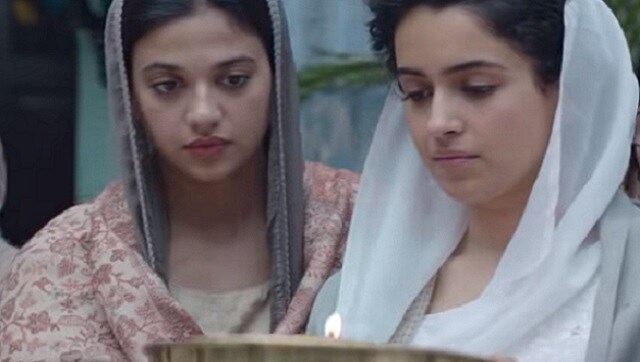The narrative arc of Nazia Zaidi in Pagglait demonstrates secularism is a hard sell these days, as much in fiction as in reality.
Shruti Sharma and Sanya Malhotra in Pagglait. YouTube
In a scene from Pagglait, the arrival of Nazia (Shruti Sharma), the Muslim friend of the mourning protagonist Sandhya (Sanya Malhotra) leaves most members of the ‘Giri’ house perplexed. The conservative family, especially its seniormost men, are evidently discomforted by the religion of their daughter’s friend.
“Nazia Zaidi”, Raghubhir Yadav says her name, visibly stricken by the presence of the unexpected guest, especially her faith, as if it belongs to a rival. It is a moment that is meant to communicate the many orthodoxies of the Indian joint family, the many anxieties it is burdened by. In a well-thought film, these layered concerns seamlessly melt into the larger narrative. In Pagglait, however, this little poke at religious friction feels like tokenism, a mere tick in the possibly large list of small-town issues that the makers felt they must address; for the sake of the climactic catharsis to seem more universal than honest. Therein lies the problem.
Secularism is a hard sell these days, as much in fiction as in reality.
Its understated presence as an elemental concern in Pagglait is proof that the makers never really intended to amplify it nor confront it head on. But so half-hearted is the attempt to bring the issue into focus, it feels like a mistaken case of easily-had redemption rather than creative foresight.
Zaidi joins Sandhya to support her in the grieving of her deceased husband. Though her faith becomes her first identifier in Sandhya’s household, it does not reappear as a matter of conversation for the entire length of the film. All of that could be forgiven, however, if it were not for the all-sweeping climax that intends to right not just the wrongs within the film, but outside as well. Sandhya brings Zaidi to the puja of the tehrvi (13th day), something that is, we are to assume, restricted for people of other faiths. Zaidi is made to reluctantly participate in something we never see her express any desire for.
Between the first and this last scene, Zaidi’s religion remains invisible, not only to the previously suspect family, but also her grieving friend. The casual pursuit of Zaidi’s affection by a man of the household does not elicit anything either. Which begs the question: what is the purpose of invoking this interfaith strain at either ends of the film? What purpose does it serve other than bear the mark of a script that hurriedly wants to kick the bucket of a conservative ritual, without actually ever discussing or humanising it. That secular progressiveness can be arrived at without so much so an acknowledgment of religious tension must be news to everyone who lives in this country – small town or big. Zaidi’s arc, her character, is robbed of a palpable pulse just so the film can make this profound yet muted statement, through the hands of the majority no less.
In a previous Netflix film, Indoo Ki Jawani, a rather immature attempt at adolescent humour, the protagonist (Kiara Advani), on desperate quest to lose her virginity, unsuspectingly meets a Pakistani boy. Though churlish in most parts, this film still humanises the rivalry of religion and nationality (India-Pakistan) better by engaging with it through the character’s lack of gravitas. Pagglait, on the other hand, comes across as a film that wants to boast of gravitas, but for some reason skims over the froth of tensions it clearly feels too important to ignore, yet too basic to extrapolate.
Similarly, the inter-faith angle in Akshay Kumar’s horrible Laxmii felt as superficial as the actor’s awfully choreographed walk. Both are different films in terms of tone and subject and yet the warring faiths in Indoo Ki Jawani come across as more honest than the insincere attempt in Pagglait at trying to deal with the world’s evils, all at once. The climax is an onslaught of do-good liberalism, executed at punching speed, one jab after the other of asphyxiating course correction that leaves you nauseous.
It makes for brilliant escapist viewing of course — have a conservative custom be overturned without having to live through its oppression or even the notion of its presence. To which effect, Pagglait strangely seems blind to its own biases, the off-centre placement of a minority, for the municipal purpose of being swept upstream by the epiphany of a central character – without a conversation, so much so a whisper of how this persecution of faith compares to the persecution of marital loss. Outside of which, the well-intended but half-assed liberal romp at the end of the film feels as soulless as it feels pointless.
It makes you wonder if filmmakers are now just assembling social issues on a board and finding narrative ways to solve them, as a way of arriving at a film. This present-day tendency of righting small-town wrongs has become a weakness that writers simply cannot seem to resist. Filmmakers feel inclined to untie complicated social-political knots before writing characters that can earn, through history and its burdens, the cathartic ends they are made to meet.
Pagglait is streaming on Netflix India.

